South African College: Counselling Modalities Comparison Essay
VerifiedAdded on 2022/09/26
|10
|2019
|156
Essay
AI Summary
This essay, submitted by Mercia Reneke to the South African College of Applied Psychology (SACAP), provides a comparative analysis of two prominent counselling modalities: person-centered therapy (PCT) and cognitive behavioral therapy (CBT). The assignment delves into the core concepts, goals, therapeutic relationships, techniques, strengths, and limitations of each approach. PCT, developed by Carl Rogers, emphasizes empathy, positive regard, and authenticity to foster client self-understanding and growth. CBT, on the other hand, focuses on identifying and modifying negative thought patterns that contribute to behavioral and emotional problems. The essay highlights the differences in how each modality approaches the therapeutic relationship, with CBT often adopting a more directive, teacher-student dynamic, while PCT prioritizes a non-directive, facilitative approach. Furthermore, the essay discusses the distinct techniques employed by each modality, such as the Socratic method in CBT and active listening in PCT. Finally, the assignment concludes by acknowledging the strengths and limitations of both approaches, underscoring their respective effectiveness in addressing various psychological issues and offering insights into how both therapies contribute to the ultimate goal of client well-being. The assignment is a valuable resource for students studying counselling modalities.

Running Header: PSYCHOLOGY
PSYCHOLOGY
Mercia Reneke
South African College of Applied Psychology (Pty) Ltd.
Counselling Modalities 1
Anelle van der Westhuizen
22 August 2019
PSYCHOLOGY
Mercia Reneke
South African College of Applied Psychology (Pty) Ltd.
Counselling Modalities 1
Anelle van der Westhuizen
22 August 2019
Paraphrase This Document
Need a fresh take? Get an instant paraphrase of this document with our AI Paraphraser

PSYCHOLOGY
Plagiarism Declaration
In accordance with SACAP’s Plagiarism Prevention Policy and Student Code of
Conduct, Wellness and Disciplinary Policy, I, Mercia Reneke, the undersigned, hereby declare
that I have abided by APA referencing guidelines, that the work contained in this assessment
submission is my own original work, and that I have not previously in its entirety, or in part,
submitted this work previously as part of a module or qualification.
Signature: Mercia Reneke Date: 22 August 2019
2
Plagiarism Declaration
In accordance with SACAP’s Plagiarism Prevention Policy and Student Code of
Conduct, Wellness and Disciplinary Policy, I, Mercia Reneke, the undersigned, hereby declare
that I have abided by APA referencing guidelines, that the work contained in this assessment
submission is my own original work, and that I have not previously in its entirety, or in part,
submitted this work previously as part of a module or qualification.
Signature: Mercia Reneke Date: 22 August 2019
2

PSYCHOLOGY
TABLE OF CONTENTS
Introduction................................................................................................................................4
Person centered and cognitive behavioral therapy.....................................................................5
Concept......................................................................................................................................5
Goals..........................................................................................................................................6
Relationship................................................................................................................................7
Techniques.................................................................................................................................7
Strengths and Limitations..........................................................................................................8
Conclusion..................................................................................................................................9
References................................................................................................................................10
3
TABLE OF CONTENTS
Introduction................................................................................................................................4
Person centered and cognitive behavioral therapy.....................................................................5
Concept......................................................................................................................................5
Goals..........................................................................................................................................6
Relationship................................................................................................................................7
Techniques.................................................................................................................................7
Strengths and Limitations..........................................................................................................8
Conclusion..................................................................................................................................9
References................................................................................................................................10
3
⊘ This is a preview!⊘
Do you want full access?
Subscribe today to unlock all pages.

Trusted by 1+ million students worldwide
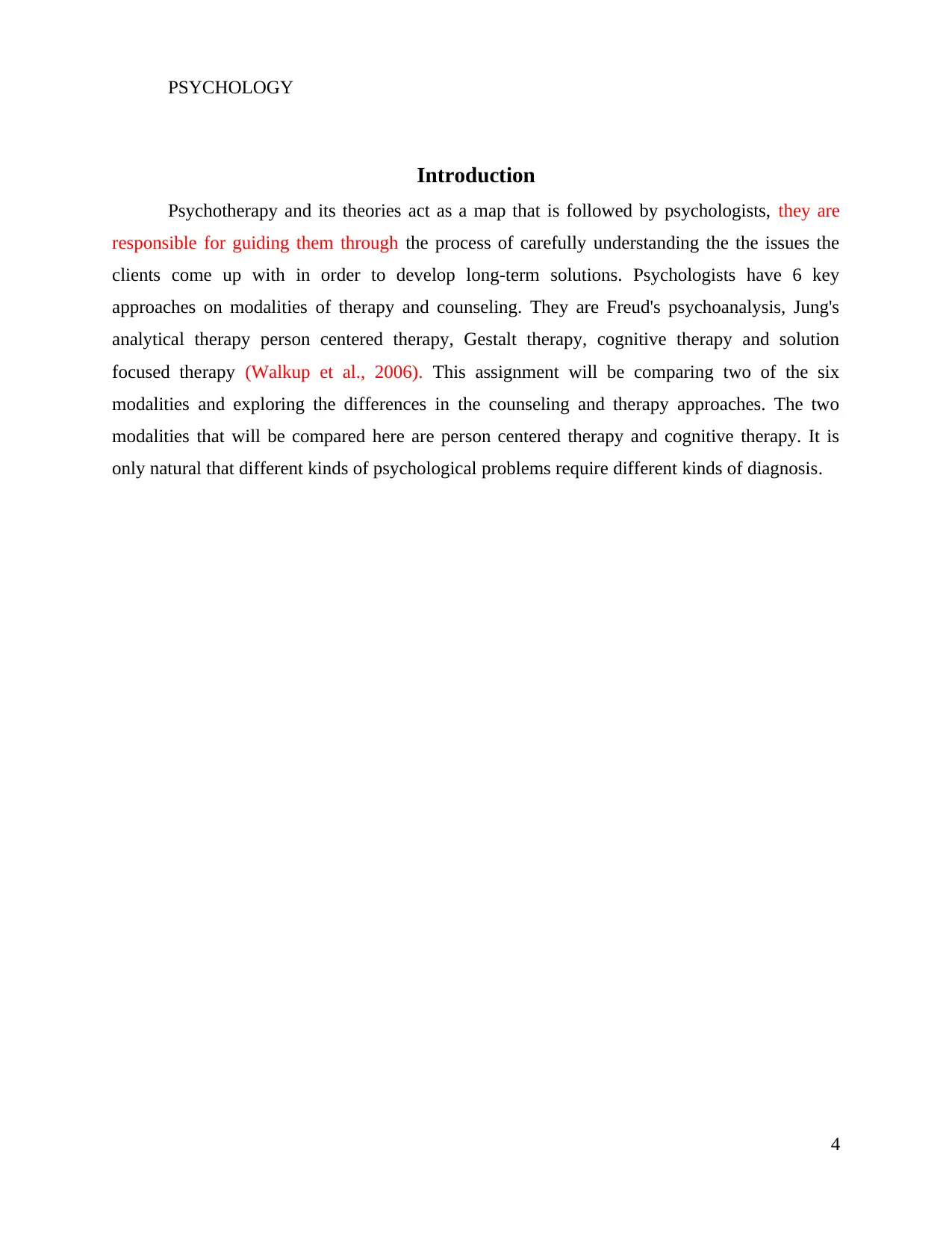
PSYCHOLOGY
Introduction
Psychotherapy and its theories act as a map that is followed by psychologists, they are
responsible for guiding them through the process of carefully understanding the the issues the
clients come up with in order to develop long-term solutions. Psychologists have 6 key
approaches on modalities of therapy and counseling. They are Freud's psychoanalysis, Jung's
analytical therapy person centered therapy, Gestalt therapy, cognitive therapy and solution
focused therapy (Walkup et al., 2006). This assignment will be comparing two of the six
modalities and exploring the differences in the counseling and therapy approaches. The two
modalities that will be compared here are person centered therapy and cognitive therapy. It is
only natural that different kinds of psychological problems require different kinds of diagnosis.
4
Introduction
Psychotherapy and its theories act as a map that is followed by psychologists, they are
responsible for guiding them through the process of carefully understanding the the issues the
clients come up with in order to develop long-term solutions. Psychologists have 6 key
approaches on modalities of therapy and counseling. They are Freud's psychoanalysis, Jung's
analytical therapy person centered therapy, Gestalt therapy, cognitive therapy and solution
focused therapy (Walkup et al., 2006). This assignment will be comparing two of the six
modalities and exploring the differences in the counseling and therapy approaches. The two
modalities that will be compared here are person centered therapy and cognitive therapy. It is
only natural that different kinds of psychological problems require different kinds of diagnosis.
4
Paraphrase This Document
Need a fresh take? Get an instant paraphrase of this document with our AI Paraphraser
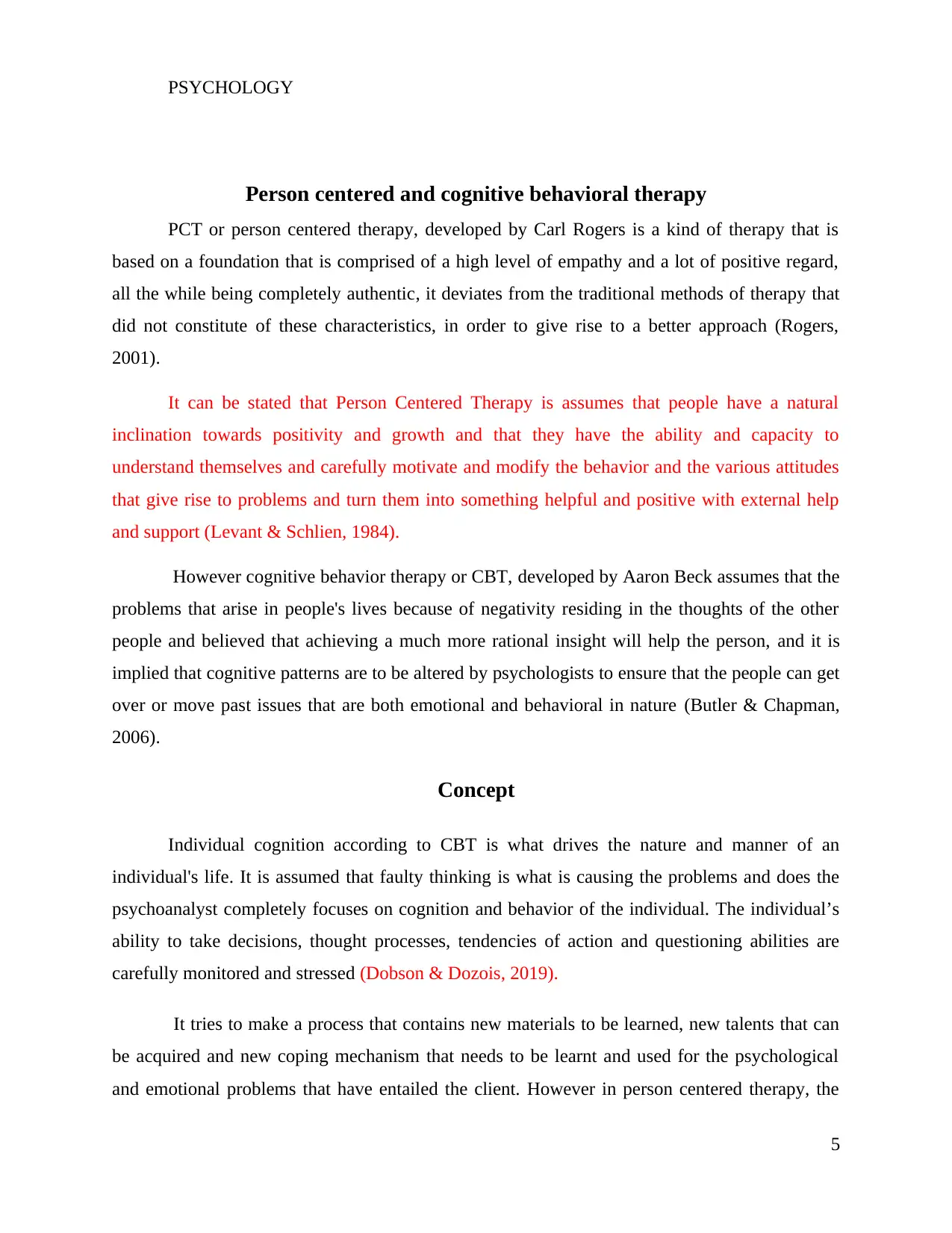
PSYCHOLOGY
Person centered and cognitive behavioral therapy
PCT or person centered therapy, developed by Carl Rogers is a kind of therapy that is
based on a foundation that is comprised of a high level of empathy and a lot of positive regard,
all the while being completely authentic, it deviates from the traditional methods of therapy that
did not constitute of these characteristics, in order to give rise to a better approach (Rogers,
2001).
It can be stated that Person Centered Therapy is assumes that people have a natural
inclination towards positivity and growth and that they have the ability and capacity to
understand themselves and carefully motivate and modify the behavior and the various attitudes
that give rise to problems and turn them into something helpful and positive with external help
and support (Levant & Schlien, 1984).
However cognitive behavior therapy or CBT, developed by Aaron Beck assumes that the
problems that arise in people's lives because of negativity residing in the thoughts of the other
people and believed that achieving a much more rational insight will help the person, and it is
implied that cognitive patterns are to be altered by psychologists to ensure that the people can get
over or move past issues that are both emotional and behavioral in nature (Butler & Chapman,
2006).
Concept
Individual cognition according to CBT is what drives the nature and manner of an
individual's life. It is assumed that faulty thinking is what is causing the problems and does the
psychoanalyst completely focuses on cognition and behavior of the individual. The individual’s
ability to take decisions, thought processes, tendencies of action and questioning abilities are
carefully monitored and stressed (Dobson & Dozois, 2019).
It tries to make a process that contains new materials to be learned, new talents that can
be acquired and new coping mechanism that needs to be learnt and used for the psychological
and emotional problems that have entailed the client. However in person centered therapy, the
5
Person centered and cognitive behavioral therapy
PCT or person centered therapy, developed by Carl Rogers is a kind of therapy that is
based on a foundation that is comprised of a high level of empathy and a lot of positive regard,
all the while being completely authentic, it deviates from the traditional methods of therapy that
did not constitute of these characteristics, in order to give rise to a better approach (Rogers,
2001).
It can be stated that Person Centered Therapy is assumes that people have a natural
inclination towards positivity and growth and that they have the ability and capacity to
understand themselves and carefully motivate and modify the behavior and the various attitudes
that give rise to problems and turn them into something helpful and positive with external help
and support (Levant & Schlien, 1984).
However cognitive behavior therapy or CBT, developed by Aaron Beck assumes that the
problems that arise in people's lives because of negativity residing in the thoughts of the other
people and believed that achieving a much more rational insight will help the person, and it is
implied that cognitive patterns are to be altered by psychologists to ensure that the people can get
over or move past issues that are both emotional and behavioral in nature (Butler & Chapman,
2006).
Concept
Individual cognition according to CBT is what drives the nature and manner of an
individual's life. It is assumed that faulty thinking is what is causing the problems and does the
psychoanalyst completely focuses on cognition and behavior of the individual. The individual’s
ability to take decisions, thought processes, tendencies of action and questioning abilities are
carefully monitored and stressed (Dobson & Dozois, 2019).
It tries to make a process that contains new materials to be learned, new talents that can
be acquired and new coping mechanism that needs to be learnt and used for the psychological
and emotional problems that have entailed the client. However in person centered therapy, the
5
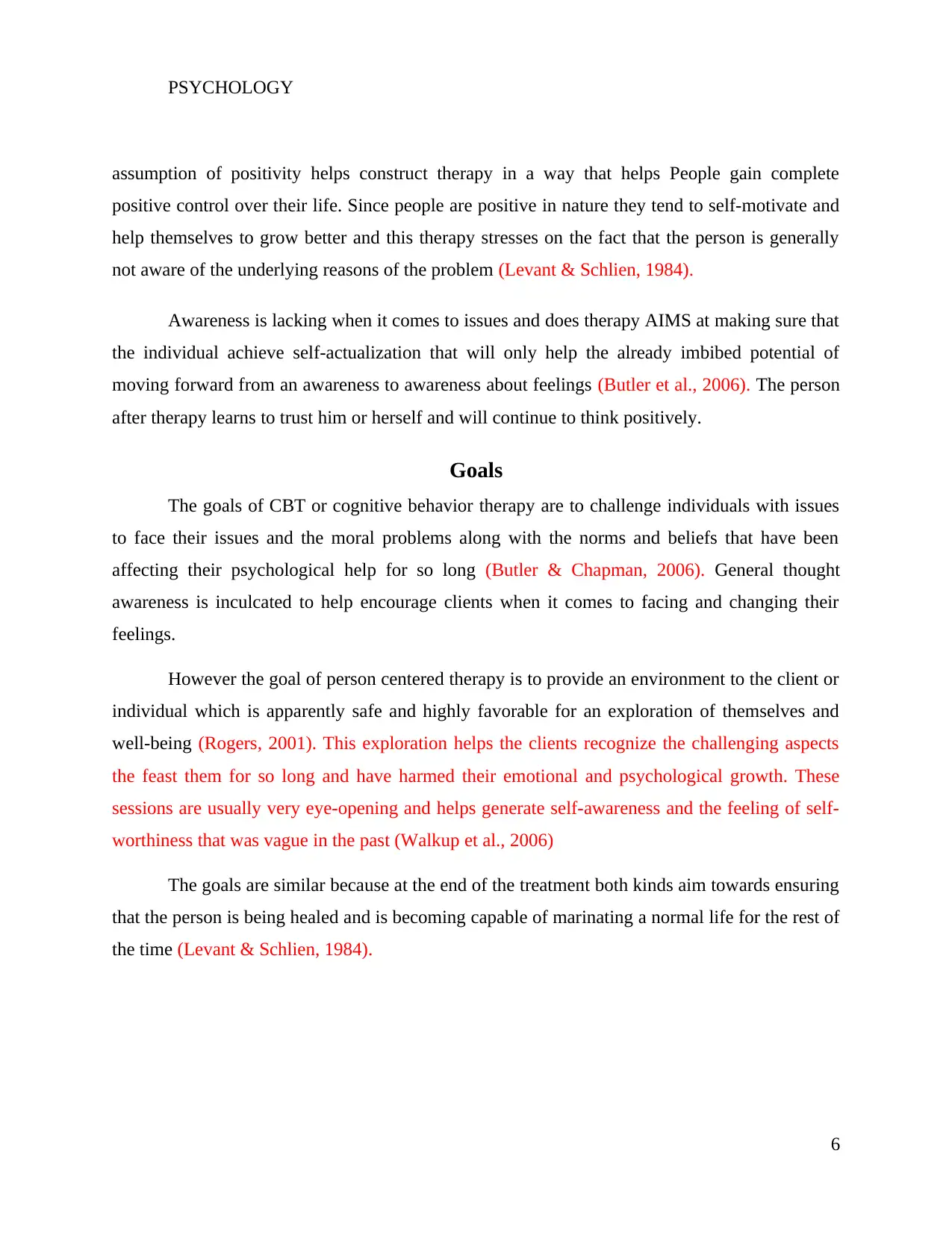
PSYCHOLOGY
assumption of positivity helps construct therapy in a way that helps People gain complete
positive control over their life. Since people are positive in nature they tend to self-motivate and
help themselves to grow better and this therapy stresses on the fact that the person is generally
not aware of the underlying reasons of the problem (Levant & Schlien, 1984).
Awareness is lacking when it comes to issues and does therapy AIMS at making sure that
the individual achieve self-actualization that will only help the already imbibed potential of
moving forward from an awareness to awareness about feelings (Butler et al., 2006). The person
after therapy learns to trust him or herself and will continue to think positively.
Goals
The goals of CBT or cognitive behavior therapy are to challenge individuals with issues
to face their issues and the moral problems along with the norms and beliefs that have been
affecting their psychological help for so long (Butler & Chapman, 2006). General thought
awareness is inculcated to help encourage clients when it comes to facing and changing their
feelings.
However the goal of person centered therapy is to provide an environment to the client or
individual which is apparently safe and highly favorable for an exploration of themselves and
well-being (Rogers, 2001). This exploration helps the clients recognize the challenging aspects
the feast them for so long and have harmed their emotional and psychological growth. These
sessions are usually very eye-opening and helps generate self-awareness and the feeling of self-
worthiness that was vague in the past (Walkup et al., 2006)
The goals are similar because at the end of the treatment both kinds aim towards ensuring
that the person is being healed and is becoming capable of marinating a normal life for the rest of
the time (Levant & Schlien, 1984).
6
assumption of positivity helps construct therapy in a way that helps People gain complete
positive control over their life. Since people are positive in nature they tend to self-motivate and
help themselves to grow better and this therapy stresses on the fact that the person is generally
not aware of the underlying reasons of the problem (Levant & Schlien, 1984).
Awareness is lacking when it comes to issues and does therapy AIMS at making sure that
the individual achieve self-actualization that will only help the already imbibed potential of
moving forward from an awareness to awareness about feelings (Butler et al., 2006). The person
after therapy learns to trust him or herself and will continue to think positively.
Goals
The goals of CBT or cognitive behavior therapy are to challenge individuals with issues
to face their issues and the moral problems along with the norms and beliefs that have been
affecting their psychological help for so long (Butler & Chapman, 2006). General thought
awareness is inculcated to help encourage clients when it comes to facing and changing their
feelings.
However the goal of person centered therapy is to provide an environment to the client or
individual which is apparently safe and highly favorable for an exploration of themselves and
well-being (Rogers, 2001). This exploration helps the clients recognize the challenging aspects
the feast them for so long and have harmed their emotional and psychological growth. These
sessions are usually very eye-opening and helps generate self-awareness and the feeling of self-
worthiness that was vague in the past (Walkup et al., 2006)
The goals are similar because at the end of the treatment both kinds aim towards ensuring
that the person is being healed and is becoming capable of marinating a normal life for the rest of
the time (Levant & Schlien, 1984).
6
⊘ This is a preview!⊘
Do you want full access?
Subscribe today to unlock all pages.

Trusted by 1+ million students worldwide
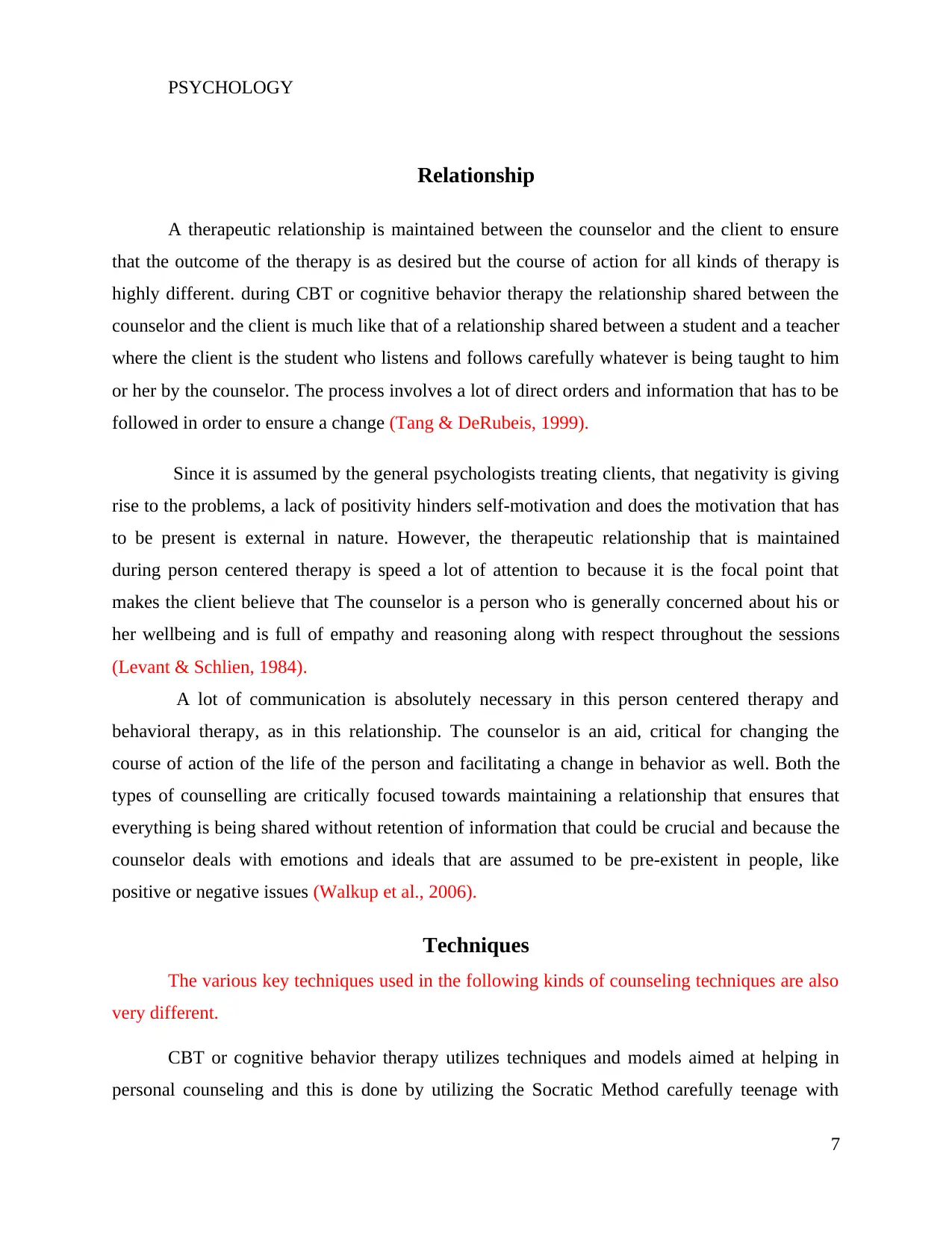
PSYCHOLOGY
Relationship
A therapeutic relationship is maintained between the counselor and the client to ensure
that the outcome of the therapy is as desired but the course of action for all kinds of therapy is
highly different. during CBT or cognitive behavior therapy the relationship shared between the
counselor and the client is much like that of a relationship shared between a student and a teacher
where the client is the student who listens and follows carefully whatever is being taught to him
or her by the counselor. The process involves a lot of direct orders and information that has to be
followed in order to ensure a change (Tang & DeRubeis, 1999).
Since it is assumed by the general psychologists treating clients, that negativity is giving
rise to the problems, a lack of positivity hinders self-motivation and does the motivation that has
to be present is external in nature. However, the therapeutic relationship that is maintained
during person centered therapy is speed a lot of attention to because it is the focal point that
makes the client believe that The counselor is a person who is generally concerned about his or
her wellbeing and is full of empathy and reasoning along with respect throughout the sessions
(Levant & Schlien, 1984).
A lot of communication is absolutely necessary in this person centered therapy and
behavioral therapy, as in this relationship. The counselor is an aid, critical for changing the
course of action of the life of the person and facilitating a change in behavior as well. Both the
types of counselling are critically focused towards maintaining a relationship that ensures that
everything is being shared without retention of information that could be crucial and because the
counselor deals with emotions and ideals that are assumed to be pre-existent in people, like
positive or negative issues (Walkup et al., 2006).
Techniques
The various key techniques used in the following kinds of counseling techniques are also
very different.
CBT or cognitive behavior therapy utilizes techniques and models aimed at helping in
personal counseling and this is done by utilizing the Socratic Method carefully teenage with
7
Relationship
A therapeutic relationship is maintained between the counselor and the client to ensure
that the outcome of the therapy is as desired but the course of action for all kinds of therapy is
highly different. during CBT or cognitive behavior therapy the relationship shared between the
counselor and the client is much like that of a relationship shared between a student and a teacher
where the client is the student who listens and follows carefully whatever is being taught to him
or her by the counselor. The process involves a lot of direct orders and information that has to be
followed in order to ensure a change (Tang & DeRubeis, 1999).
Since it is assumed by the general psychologists treating clients, that negativity is giving
rise to the problems, a lack of positivity hinders self-motivation and does the motivation that has
to be present is external in nature. However, the therapeutic relationship that is maintained
during person centered therapy is speed a lot of attention to because it is the focal point that
makes the client believe that The counselor is a person who is generally concerned about his or
her wellbeing and is full of empathy and reasoning along with respect throughout the sessions
(Levant & Schlien, 1984).
A lot of communication is absolutely necessary in this person centered therapy and
behavioral therapy, as in this relationship. The counselor is an aid, critical for changing the
course of action of the life of the person and facilitating a change in behavior as well. Both the
types of counselling are critically focused towards maintaining a relationship that ensures that
everything is being shared without retention of information that could be crucial and because the
counselor deals with emotions and ideals that are assumed to be pre-existent in people, like
positive or negative issues (Walkup et al., 2006).
Techniques
The various key techniques used in the following kinds of counseling techniques are also
very different.
CBT or cognitive behavior therapy utilizes techniques and models aimed at helping in
personal counseling and this is done by utilizing the Socratic Method carefully teenage with
7
Paraphrase This Document
Need a fresh take? Get an instant paraphrase of this document with our AI Paraphraser
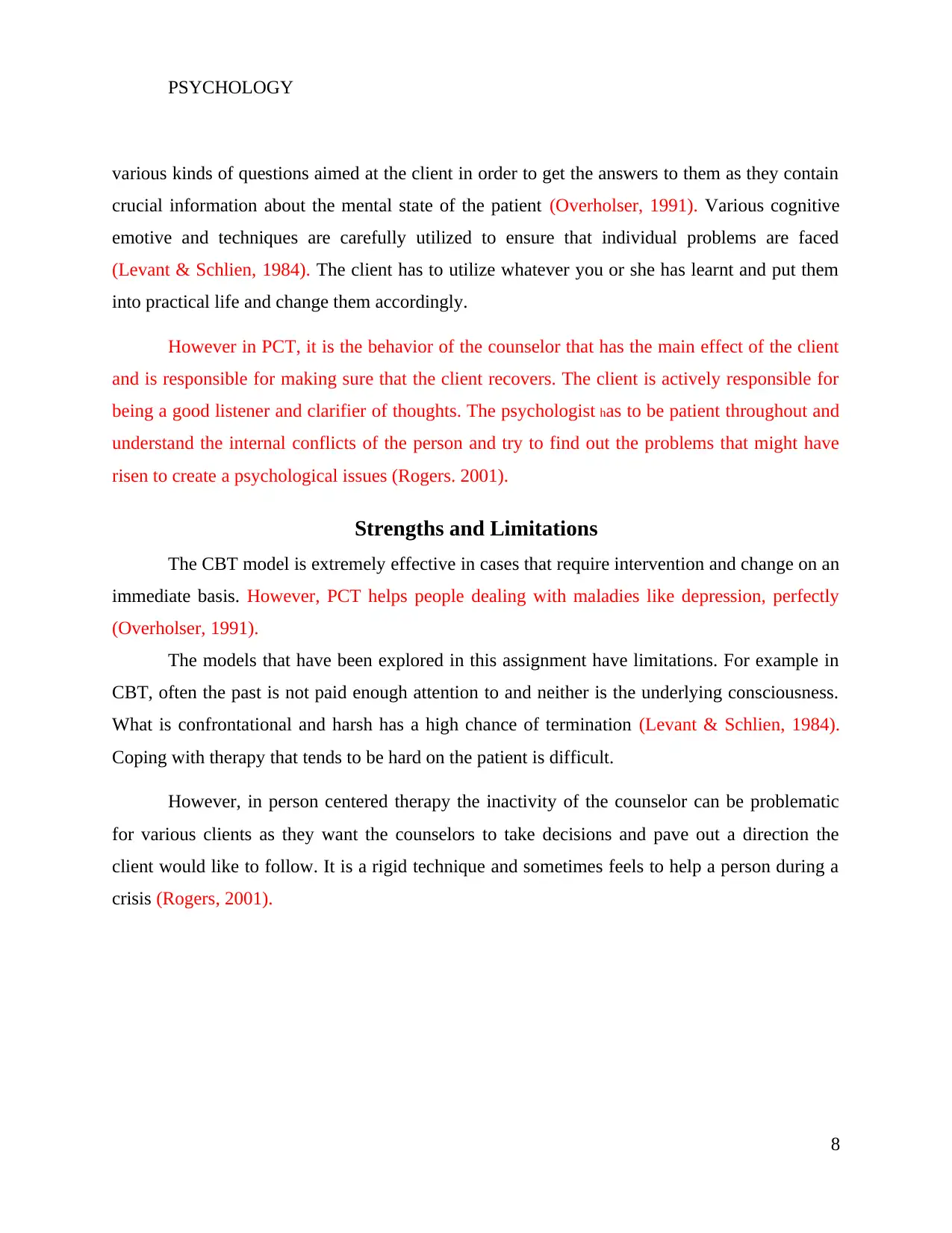
PSYCHOLOGY
various kinds of questions aimed at the client in order to get the answers to them as they contain
crucial information about the mental state of the patient (Overholser, 1991). Various cognitive
emotive and techniques are carefully utilized to ensure that individual problems are faced
(Levant & Schlien, 1984). The client has to utilize whatever you or she has learnt and put them
into practical life and change them accordingly.
However in PCT, it is the behavior of the counselor that has the main effect of the client
and is responsible for making sure that the client recovers. The client is actively responsible for
being a good listener and clarifier of thoughts. The psychologist has to be patient throughout and
understand the internal conflicts of the person and try to find out the problems that might have
risen to create a psychological issues (Rogers. 2001).
Strengths and Limitations
The CBT model is extremely effective in cases that require intervention and change on an
immediate basis. However, PCT helps people dealing with maladies like depression, perfectly
(Overholser, 1991).
The models that have been explored in this assignment have limitations. For example in
CBT, often the past is not paid enough attention to and neither is the underlying consciousness.
What is confrontational and harsh has a high chance of termination (Levant & Schlien, 1984).
Coping with therapy that tends to be hard on the patient is difficult.
However, in person centered therapy the inactivity of the counselor can be problematic
for various clients as they want the counselors to take decisions and pave out a direction the
client would like to follow. It is a rigid technique and sometimes feels to help a person during a
crisis (Rogers, 2001).
8
various kinds of questions aimed at the client in order to get the answers to them as they contain
crucial information about the mental state of the patient (Overholser, 1991). Various cognitive
emotive and techniques are carefully utilized to ensure that individual problems are faced
(Levant & Schlien, 1984). The client has to utilize whatever you or she has learnt and put them
into practical life and change them accordingly.
However in PCT, it is the behavior of the counselor that has the main effect of the client
and is responsible for making sure that the client recovers. The client is actively responsible for
being a good listener and clarifier of thoughts. The psychologist has to be patient throughout and
understand the internal conflicts of the person and try to find out the problems that might have
risen to create a psychological issues (Rogers. 2001).
Strengths and Limitations
The CBT model is extremely effective in cases that require intervention and change on an
immediate basis. However, PCT helps people dealing with maladies like depression, perfectly
(Overholser, 1991).
The models that have been explored in this assignment have limitations. For example in
CBT, often the past is not paid enough attention to and neither is the underlying consciousness.
What is confrontational and harsh has a high chance of termination (Levant & Schlien, 1984).
Coping with therapy that tends to be hard on the patient is difficult.
However, in person centered therapy the inactivity of the counselor can be problematic
for various clients as they want the counselors to take decisions and pave out a direction the
client would like to follow. It is a rigid technique and sometimes feels to help a person during a
crisis (Rogers, 2001).
8
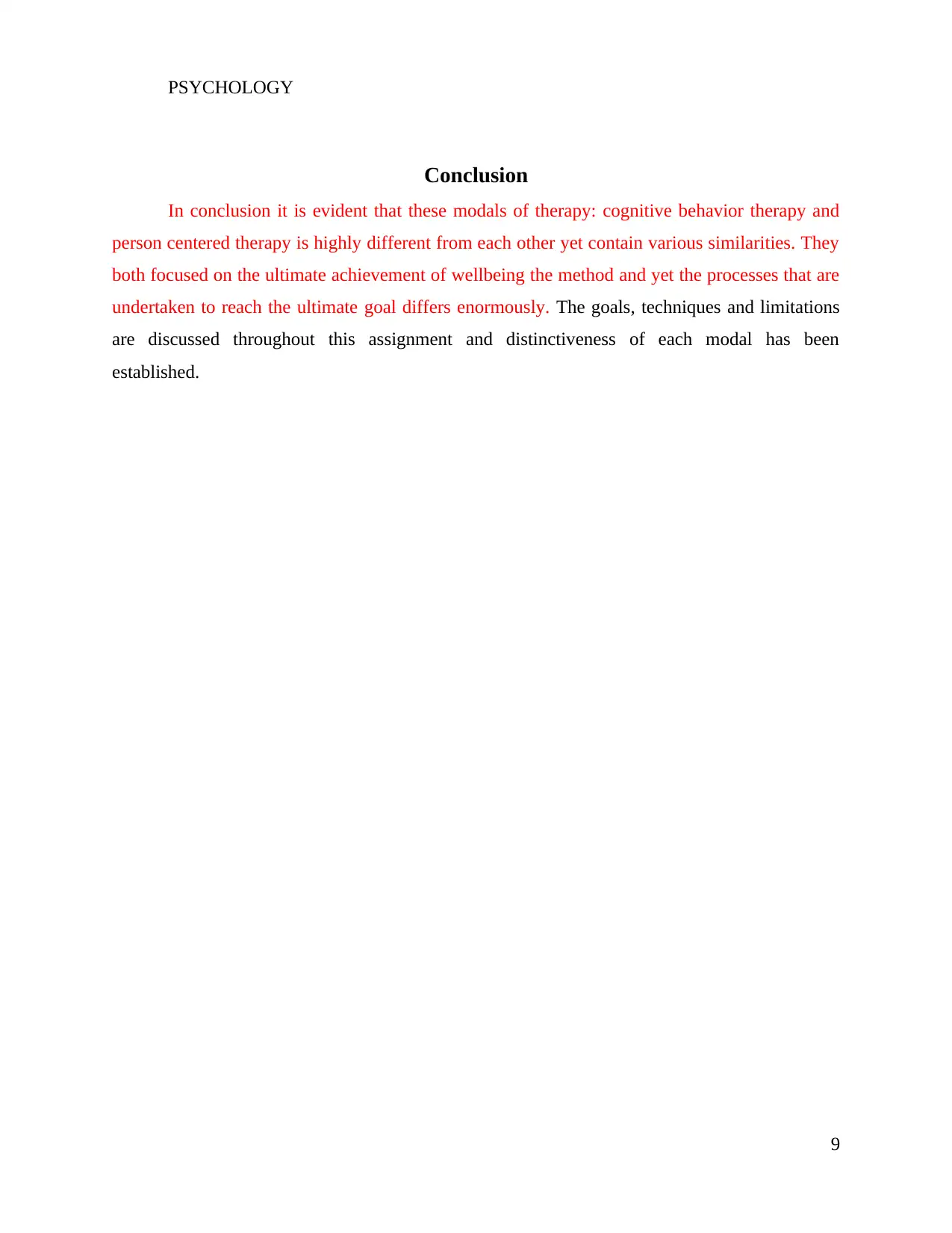
PSYCHOLOGY
Conclusion
In conclusion it is evident that these modals of therapy: cognitive behavior therapy and
person centered therapy is highly different from each other yet contain various similarities. They
both focused on the ultimate achievement of wellbeing the method and yet the processes that are
undertaken to reach the ultimate goal differs enormously. The goals, techniques and limitations
are discussed throughout this assignment and distinctiveness of each modal has been
established.
9
Conclusion
In conclusion it is evident that these modals of therapy: cognitive behavior therapy and
person centered therapy is highly different from each other yet contain various similarities. They
both focused on the ultimate achievement of wellbeing the method and yet the processes that are
undertaken to reach the ultimate goal differs enormously. The goals, techniques and limitations
are discussed throughout this assignment and distinctiveness of each modal has been
established.
9
⊘ This is a preview!⊘
Do you want full access?
Subscribe today to unlock all pages.

Trusted by 1+ million students worldwide
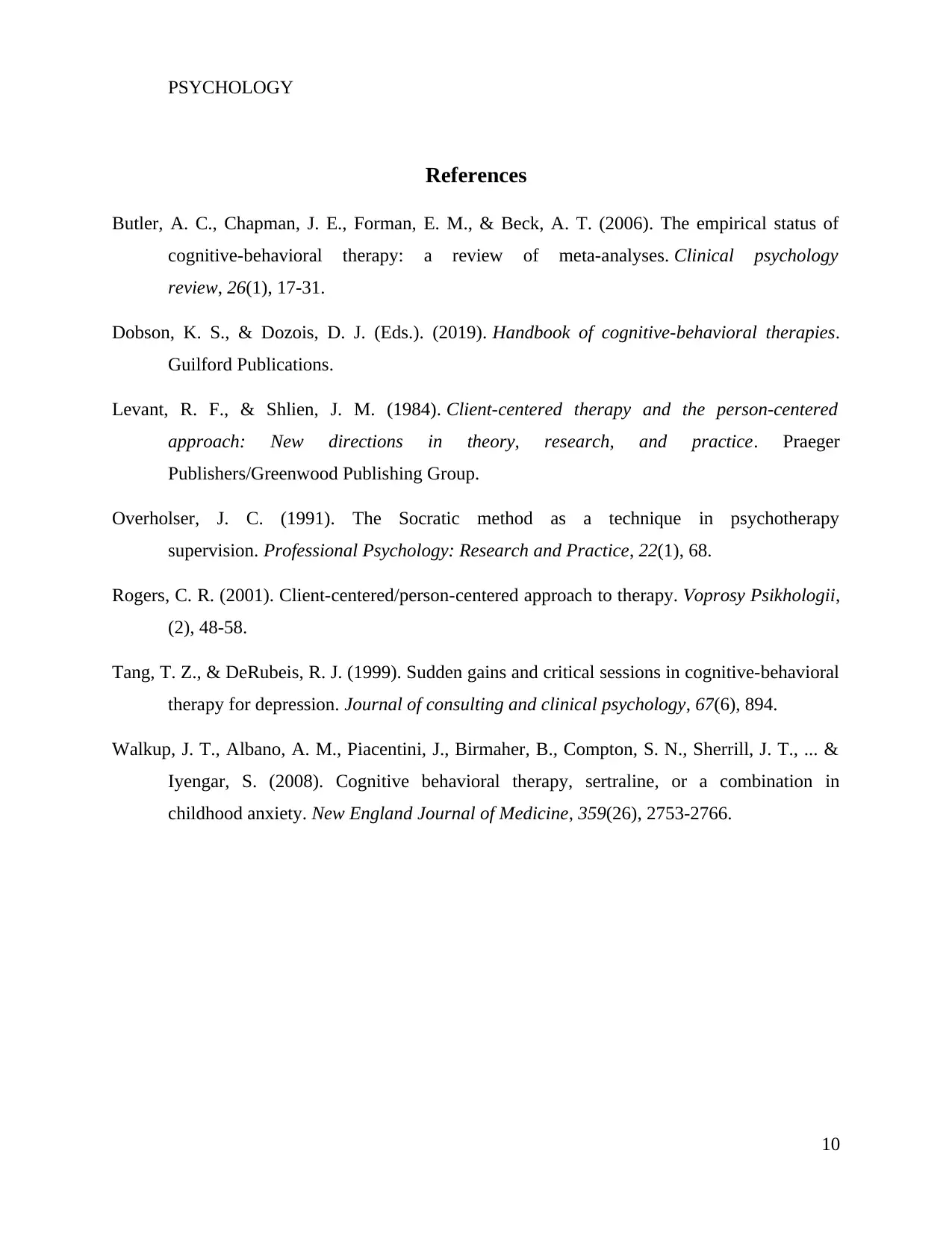
PSYCHOLOGY
References
Butler, A. C., Chapman, J. E., Forman, E. M., & Beck, A. T. (2006). The empirical status of
cognitive-behavioral therapy: a review of meta-analyses. Clinical psychology
review, 26(1), 17-31.
Dobson, K. S., & Dozois, D. J. (Eds.). (2019). Handbook of cognitive-behavioral therapies.
Guilford Publications.
Levant, R. F., & Shlien, J. M. (1984). Client-centered therapy and the person-centered
approach: New directions in theory, research, and practice. Praeger
Publishers/Greenwood Publishing Group.
Overholser, J. C. (1991). The Socratic method as a technique in psychotherapy
supervision. Professional Psychology: Research and Practice, 22(1), 68.
Rogers, C. R. (2001). Client-centered/person-centered approach to therapy. Voprosy Psikhologii,
(2), 48-58.
Tang, T. Z., & DeRubeis, R. J. (1999). Sudden gains and critical sessions in cognitive-behavioral
therapy for depression. Journal of consulting and clinical psychology, 67(6), 894.
Walkup, J. T., Albano, A. M., Piacentini, J., Birmaher, B., Compton, S. N., Sherrill, J. T., ... &
Iyengar, S. (2008). Cognitive behavioral therapy, sertraline, or a combination in
childhood anxiety. New England Journal of Medicine, 359(26), 2753-2766.
10
References
Butler, A. C., Chapman, J. E., Forman, E. M., & Beck, A. T. (2006). The empirical status of
cognitive-behavioral therapy: a review of meta-analyses. Clinical psychology
review, 26(1), 17-31.
Dobson, K. S., & Dozois, D. J. (Eds.). (2019). Handbook of cognitive-behavioral therapies.
Guilford Publications.
Levant, R. F., & Shlien, J. M. (1984). Client-centered therapy and the person-centered
approach: New directions in theory, research, and practice. Praeger
Publishers/Greenwood Publishing Group.
Overholser, J. C. (1991). The Socratic method as a technique in psychotherapy
supervision. Professional Psychology: Research and Practice, 22(1), 68.
Rogers, C. R. (2001). Client-centered/person-centered approach to therapy. Voprosy Psikhologii,
(2), 48-58.
Tang, T. Z., & DeRubeis, R. J. (1999). Sudden gains and critical sessions in cognitive-behavioral
therapy for depression. Journal of consulting and clinical psychology, 67(6), 894.
Walkup, J. T., Albano, A. M., Piacentini, J., Birmaher, B., Compton, S. N., Sherrill, J. T., ... &
Iyengar, S. (2008). Cognitive behavioral therapy, sertraline, or a combination in
childhood anxiety. New England Journal of Medicine, 359(26), 2753-2766.
10
1 out of 10
Your All-in-One AI-Powered Toolkit for Academic Success.
+13062052269
info@desklib.com
Available 24*7 on WhatsApp / Email
![[object Object]](/_next/static/media/star-bottom.7253800d.svg)
Unlock your academic potential
Copyright © 2020–2025 A2Z Services. All Rights Reserved. Developed and managed by ZUCOL.


